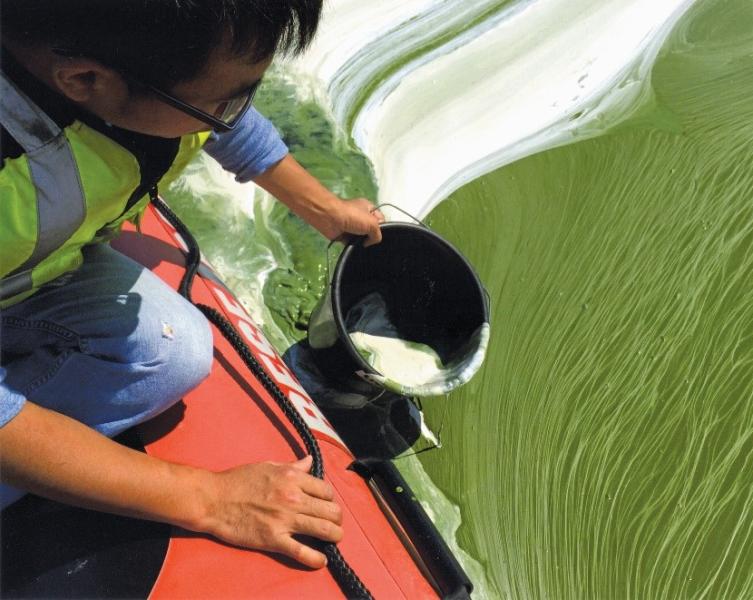New Insights on how Different Extreme Events Interact with Each Other Effects Cyanobacteria Blooms in Vermont's Missisquoi Bay

Photo by Joel Banner Baird, Burlington Free Press
January 20, 2022
Contact:
epscor@uvm.edu By: Carolyn Shapiro
In the heat of summer, signs go up at beaches and access points around Lake Champlain, warning of the presence of cyanobacteria and its potential dangers to people and pets. Scientists and lake experts have predicted that climate change will spur the formation of blue-green algae blooms, which harm water quality and recreational use of the lake by residents and tourists.
Now, a new study led by a team of researchers based at the University of Vermont has applied a unique modeling method to more precisely assess the influences of temperature and precipitation – and the relationship between them – on cyanobacteria growth. They focused on Missisquoi Bay, a shallow swath of northeastern Lake Champlain where cyanobacteria is prevalent.
The study was published last week in the journal Science of the Total Environment by a multidisciplinary team working with the Vermont Established Program to Stimulate Competitive Research, or VT EPSCoR, funded by the National Science Foundation.
“We wanted to really get a sense of the relationship between floods and droughts and how they might change with climate, and if you put them all together, what the impact will be on blooms in the Missisquoi Bay,” said Jory Hecht, who led the study as a postdoctoral graduate student with VT EPSCoR and is now a hydrologist with the U.S. Geological Survey in Massachusetts.
The researchers found that major storms, such as Nor'easters and hurricanes, followed by prolonged periods of heat – even a year or more after those storms – created the ripest atmosphere for the blue-green algae, which is not actually algae but bacteria. “We're trying to get a better understanding of how different types of extreme events can interact with each other,” Hecht said. “We saw in the results that the sequences of these extremes really mattered.”
The study authors hope their work, fueled by the power of interdisciplinary research and super-computing, will provide crucial data for policymakers trying to address climate change and mitigate its consequences for one of the Northeast's most significant bodies of water. State and federal environmental agencies can incorporate this information into their lake pollution management plans, said Asim Zia, a UVM professor of public policy and computer science and another of the study's authors.
“To me, the biggest action that we can take now is to reduce the greenhouse gas emissions, Zia said, citing federal and state guidelines for phosphorus levels in Lake Champlain. “Those regulatory targets need to account for climate change-induced extreme events. You can make those targets more realistic in terms of what's coming.”
The study might surprise some Lake Champlain observers. Heavy rain storms are known to cause increased runoff from the watershed – the farms and developed lands along creeks and streams – that channels excess nutrients such as phosphorus, nitrogen and carbon into the lake. The UVM team discovered, however, that storm-related phosphorus dumps are not necessarily the primary driver of cyanobacteria growth, particularly in the lake's most shallow areas. Missisquoi Bay is “remarkably shallow,” Hecht said – 14 feet deep at its deepest point, across more than 30 square miles of surface area.
“One thing that's interesting about our research is that it's not as simple as the more it rains, the more phosphorus is dumped into the lake, and the more blooms we have,” he said.
Big rainstorms do wash nutrients that feed the algae into the lake, but those events also cool and churn up the water, which helps prevent algae growth. Blooms depend heavily on “legacy” phosphorus that has settled into the sediment of the lake bottom from watershed runoff in years past, Hecht said. If water remains still and warm in a shallow area with high amounts of legacy phosphorus, the light and warmth of the sun can easily reach the sediment, which stimulates cyanobacteria.
“The bigger threat are the droughts,” Zia said. “To me this is one of the key findings of this: When the droughts happen, especially in shallow bays, like the way Missisquoi Bay is, the drought basically slows down the flushing out of the nutrients and creates those conditions, mixed with the warmer water.”
This study is part of a larger project, called Basin Resilience to Extreme Events, awarded from the National Science Foundation in 2016, to assess Lake Champlain's response to increasingly extreme events and to provide data to assist policymakers and economic development initiatives. To read the full study visit
https://www.sciencedirect.com/science/article/abs/pii/S004896972106664X?dgcid=author
